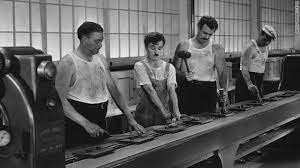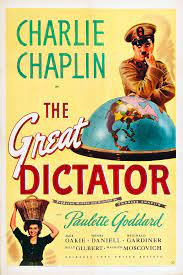This blog is written in response to the Thinking Activity on the frame study of the Charlie Chaplin's movies, 'Modern Times' And 'The Great Dictator' given by Dr. Dilip Barad sir at the Department of English, MKBU.
Frame study of Charlie Chaplin movies ‘Modern Times’ and ‘The Great Dictator’
When we want to know about important events and People of any time, we go to the history books or news but when we want to Know about the spirit of the time or the people in general we go to the literature. In the present time movies have become an essential part of the literature and also very helpful to understand the people, their psychology, changing time and nature of society and the world. Nowadays some movies are senseless and some have extreme sense in them, but we are going to talk about a person(Charlie Chaplin) who lived before us but his understanding and sense of making movies and his filmography is making sense even after a long time.
To understand the time and the setting of the 20th century.
The two films of Charlie Chaplin, ‘Modern Times’ and ‘The Great Dictator’ are very helpful movies to understand the setting and zeitgeist of the first half of the 20th century. Different frames of the movies wonderfully represent the time and people of the 20th century.
Charlie Chaplin’s movies are comedic and more for entertainment, but that does not stop him to become critical, and it in fact helps him to put layers in his movies. As they both fulfill a critical approach and awesome entertainment. Charlie’s Modern Times Criticizes the Industrialization and how society is becoming artificial and machine like and in “The Great Dictator” he mocks Hitler and the dictatorship and how the world leaders acts and how it impacts the common people.
‘Modern TImes' is movie released in 1936 and it’s about a factory worker who tries to live in the world that is changing very fast and a poor girl who wants to raise herself from poverty. The movie is considered as the last great silent movie. It was a satire of modern age and contained various themes like, the dehumanizing effects of many aspects of modernity, including industrialization, bureaucracy, urbanization, and law enforcement.
‘The Great Dictator’ was released in the year 1940 and through the film Charlie Chaplin satirized the dictatorship as in that time various countries were ruled by dictators, in particular Germany by Hitler. The dispute between Aryan and Jewish people and the country's situation is presented by the double roles of Chaplin as Hynkel and Jewish Barber.
Impact of the industrialization
The movie “Modern times” begins with note that goes like this,
“Modern Times, story of industry, individual enterprise and humanity crusading in pursuit of happiness”.
The story revolves around the Tramp character of Charlie Chaplin and as the film goes on we discovers various aspects of the industrialization effect on the human life and the social conditioning of the 20th century.
The very first scene holds a very deep meaning as it depicts modern life, that the way of living has become artificial and mechanical and the word is relaxing on the clock and all the people follow an invisible root of life, like sheep following each other. All controlled by the clock.
In the present time also we learn how to cope up with the modern world, how to blend ourselves with others. We all learn to get used to and become one of the crowd and how to get along with the flow.

The machinery and the people is also very deeply meaningful as they represent the laborers of the factories and the working class people. The bosses of the factories want to gain more and more profits and that's why they make more pressure to work and live like machines. The work stress of the factory and company of the machinery leads The Tramp to the bad mantel conditioning and the requirement of psychological help.
The industrialization is spreading and progressing but on the other hand there is no relevance to it with the common life. The owners of factories and industrial rich people are becoming more and more rich but the poor laborers and common people are becoming even poorer.
This understanding comes from the girl who steals Bananas and takes them to her house where her two young sisters wait for food. Their father is a factory worker who lost his job and then dies in a protest against the factory owners. Through the Girls story we see how the government system fails to provide help to the people in need and how it also creates problems rather than solving them.
The Tramp and The Poor Girl together try to win against the cruel world but they always fail. They dream about a simple dream of home, happiness and more than anything the food. They want to fulfil the basic need of food as they don’t get that much at the end of the day.
The dictatorship and their propaganda.
In ‘The Great Dictator’, Charlie Chaplin makes a parody of the German leader Adolf Hitler through the character of Dictator Hynkel. Charlie played double roles of Hynkel and a Jewish Barber.
The portrait of Hynkel highlights how dictators become selfish and favors only those who roam around them. They hear what they want to and do whatever they please and what benefits their propaganda.
From public support and weapon power they become leaders and rulers and then they dream of ruling the whole world. The dictatorship becomes favorable to only one group of the people of one part of the society. Their main purpose becomes political gains and fulfillment of their propaganda.
The character of Hynkel is a dictator who is a pretentious and hypocritical person who favors the general who always does something to please him and punish those who oppose him or tries to give sensible ideas.
Through the Jewish barber we see the life of Jewish people in the rule of the dictator. How the Jewish colonies are marked and the police harass the common people and the common people lives in the terror of the authorities. The Jewish people once were also part of the nation as the Aryans, but they lived in the Ghetto.
The Ghettos were colonies where Jewish people lived in various countries as they were minorities, but now the term Ghetto is applied to the minority living areas where people live, like minorities, immigrants and poor peoples.
The division of colonies was very significant at that time. Industrialism also divided the colonies as the dictatorship. There are two areas one is the ghetto where Jewish people live and in the other the Aryan lives. Same way in other parts of the world through industries was the division of rich and poor people. Rich live in lavish and luxurious areas while the poor and working class people live in ghetto type places.













No comments:
Post a Comment